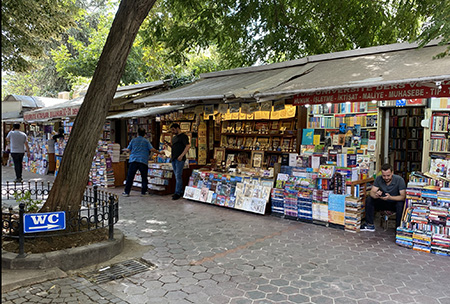Istanbul’s Grand Bazaar – Part 1- The Book Bazaar
One of the places most tourists put on their itinerary when they visit Istanbul is their famous Grand Bazaar. There were a few things I was specifically looking for this trip, so we planned ahead. Much of the bazaar is like other areas of the city- shops grouped together by similar products. You have the spice bazaar, the book bazaar, fabric stores, etc. There are 9 separate gates to to get into the Grand Bazaar, which is also called just the “covered market” in Turkish. Entering one gate, we went through a metal detector and had a metal detection wand go over our bags and persons. At another gate, they were checking temperatures for Covid. The market wasn’t the usual heavily populated hustle & bustle, particularly as it was a Saturday, so I assume that Covid continues to concern both tourists and Turkish citizens alike.

Part of the Book Bazaar outside the halls of the Grand Bazaar.
The first place we stopped was the book bazaar. I was looking to see it they had any books on Turkish embroidery that I might not find in the states. As an aside… cats are everywhere in Istanbul. People feed them regularly. You see kittens frequently- something I find delightful and so uncommon in our society unless you go to a shelter or breeder. Their policy on stray dogs is also very humane. They spay or neuter them, tag them, and let them go free and the community feeds them.

Kittens playing amidst the books
I was ecstatic when I found “Cankiri’da Bulunan Sakli Hazineler” – OK, I didn’t know what the title said, but the photos are stupendous! With beautiful pictures of museum pieces, I’m thrilled to add it to my library and happy to have it as another source for my studies of Turkish and Ottoman embroidery.

“Cankiri’da Bulunan Sakli Hazineler – A catalogue of textiles and garments from the Cankiri Museum.

Detail of a bohça – an embroidered cloth used to wrap a parcel or bundle.

Detail of the embroidery from the bohça
I’ve been studying Turkish embroidery for my “Experimental Research for Advanced Design” graduate course at the Gail Harker Center for Creative Arts. This includes getting to know the different types of items that have been embroidered as well as their stitches. One of the common items is a yağlık. Originally, this term referred to a rectangular piece of cotton or linen fabric, embroidered at both ends and used as a napkin at dinner. Yağlik was not necessarily an individual napkin, but used to catch the bread crumbs and food particles in front of diners seated around large food trays. Such elaborately decorated textiles could be used in the Ottoman palace or at the homes of the rich, but it was not practical for the ordinary to use them at meal times. Eventually, yağlik became an embroidered textile to be used on special occasions to decorate homes and gained use as a gift item. It was also a treasured part of the trousseaus of young women. Normally, it is 45-50 cm wide and about 130-140 cm long. The height of the embroidered area at both ends is about 15-20 cm. In this study, yaglik is defined as a decorated towel (not terry cloth, but plain, woven textile).

Detail image from a yağlık (long napkin/towel) of Turkish embroidery from the Cankiri Museum.

Page showing a yağlık both full and detail images

Detail of the embroidery
They also had a pattern book that was quite nice, showing a color picture of a piece of contemporary Turkish embroidery (mostly from 2000-2015) and the pattern so you could make the piece yourself. While I didn’t purchase that one, it was fun and interesting to see the contemporary designs.
Next… on to the textiles at the Bazaar!
